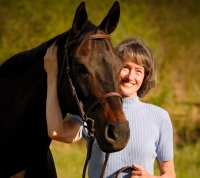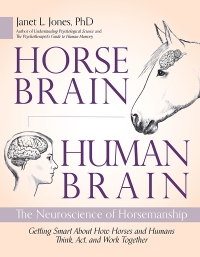TRUE TRAINING 82 - Indoor Arenas
So much of brain-based horsemanship depends on forming a bond of mutual trust between horse and rider. Every day, I am reminded that my methods of teaching a horse a given maneuver have two purposes. One, of course, is to accomplish the maneuver—loping more slowly, developing a rounder arc over a jump, achieving a flying lead change, negotiating a bridge, or whatever the goal might be.
But the much more important purpose of training is to build trust with the horse, to teach her that I am her guide. She can rely on me, no matter what the human world might throw her way. True’s lessons involve both of these purposes. Settling him into an indoor arena is a good example.
Indoor arenas are rare in many locations, so many horses and humans are unaccustomed to them. I grew up riding horses outdoors in every kind of weather. At most, we had a covered arena for rain, but the only place we rode indoors was at coliseum venues for big horse shows. Even today, I am more comfortable riding outdoors. Horses pick up that emotion in their riders—a slight tension or guardedness that’s different from the usual feel. (Yes, horses develop “feel” much like riders do… but that topic will have to wait for a different post.)
True was lucky to have a breeder who took him to a local indoor arena occasionally when he was two years old. Even so, he was nervous when we began working in an indoor a year ago on a regular basis. Almost all horses are. Indoor arenas produce noises whose cause cannot be seen or identified. Their doors swing open and slam shut unexpectedly in the wind. Visitors don’t realize they need to voice a warning before punching the button to lift an electric garage door on one end. People appear at the gate suddenly and silently, as if from nowhere. Any prey animal worth her salt is going to be startled by these activities, at least at first.
So, how did I teach True to settle in an indoor arena? SLOWLY! One of the biggest problems I see between horses and riders is the human desire to proceed too quickly. Slow down, take your time, give that equine prey brain a chance. Proceed only when the horse proves she is ready for the next baby step. And my one absolute rule: Never punish fear.
For the first couple of days, I led True around the indoor arena on a halter. The main objective was simply to keep him calm, so I rewarded with strokes and praise whenever he expressed calm or relaxed behavior. When he shied or became nervous, I simply kept leading--the best response for undesired behavior in a scary situation is complete neutrality, not punishment. I let True determine the safe distance from new objects, rather than determining that distance for him and urging him to approach. Soon he walked calmly with me in all areas of the arena, though he still startled when a noise from outside occurred or a door opened. So did I.
For the next two weeks, I simply turned True loose and stayed in the indoor arena with him. No halter to catch on the gates, just a naked horse doing whatever he wants to do. True’s first objective was to sniff every grain of sand in the place. Over 14 days, he sniffed here, then there, sniffed the walls and gates, investigated every rail of the fence, looked up at the banners on the walls, and watched for all the nonexistent killer birds, Ninja cows, and loose dogs. He checked every corner. I sat and read, available if he needed me but not involved in his exploration.
After a few days, when True had sniffed and re-sniffed every molecule of the place, he began to run. It’s important that he made this decision on his own. I did not encourage him to run, carry a whip, fling a rope at him, cluck, clap, or anything else. True began galloping the indoor for 45 minutes at a time, lots of figure eights, some playful bucks in the corners, occasional halts to blow and snort, shying and bolting at surprises.
At first, I was available in the arena but not participating in this activity; later I worked in the barn aisle nearby while True galloped. After a couple of weeks of daily gallops, True slowed down and mostly just walked in the indoor. Finally, his running time diminished to only two or three minutes before he came to the gate and stood waiting for me to come get him. That was my signal he was ready for more.
How much time the horse needs for all this preliminary work is entirely up to the horse; yours might take less time or more, but in general, equine brains need more time than human brains think they do. Studies of heart rate, blood pressure, and cortisol show that horses frequently experience more anxiety than they show.
Many—probably most—trainers would scoff at “wasting” a month on all this exploration. But here’s where trust comes in. The primary goal is to build trust; riding in the arena is only secondary. Why? Because trust will serve the horse-and-human team well for all future achievements, and if built correctly it will expand rather than dissipate.
It’s a lot faster to force a horse to adapt to something new. I see many trainers punish horses for fear. Upon shying or evading any area of a new indoor arena, these trainers kick the horse’s shoulders, wrench their necks back and forth, spur hard, jerk on bridles, and worse—all in an apparent effort to teach the horse to distrust and fear her rider. That fear can result in a horse who isn’t worried about the noises and surprises of an indoor arena—she’s so terrified of her rider, that her brain is focused there. In other words, the rider becomes a greater danger than the arena is. I prefer to take the slow road that develops a true partnership with the horse, a positive experience rather than a negative one.
After about a month of sniffing, exploring, and galloping, True was ready to go to work inside the big box. We began tacked up on a longe line. True has tremendous energy and strength, so it helps to get a few of the bucks out before I hop on. Longeing also reminds him of his work manners, the commands for control, the lessons in reward for good behavior. After each longeing session of perhaps 10-15 minutes, I got on and rode him.
Horses are always more nervous with a rider than without. So, when mounted, True needed time to walk the indoor again, to experience all the different objects in it: a cutting flag, barrels, other horses, jumps, a mechanical steer, doors that opened as if with a will of their own, windows through which blurred activities and human movements could be seen, fans clacking and whining in the wind, the whinnies of unseen friends. Over time, I longed less and rode more, until finally it was all riding.
We also moved toward less mounted walking and more mounted trotting and cantering. Week by week, various unexpected events occurred that spooked True—but the bond of trust meant that he knew I was always there to help. When he spooked, I tried to simply keep him moving forward at whatever task we had been working on. When I spooked, True was usually generous—like the day a worker walked around repairing the roof without mentioning to indoor riders that he was there!
On average, we’ve worked in that indoor arena for about six months now, taking our outdoor summer rides into account. True is comfortable most of the time, but always more alert than in an outdoor arena. He finally adjusted to the red barrel that scared him for weeks at the beginning. Just the other day, someone exchanged the red barrel for a white one in the middle of the night and True nearly lost his cookies. “White!”—a much more vivid color than red to a horse’s eyes—“How did it suddenly turn WHITE??!!” he seemed to say. But this time, it took only two days for him to accept the white barrel.
True will get calmer in the indoor arena every day. Why? Because he trusts me to guide his behavior there. So, train more for trust, less for surface maneuvers, and never for fear.

